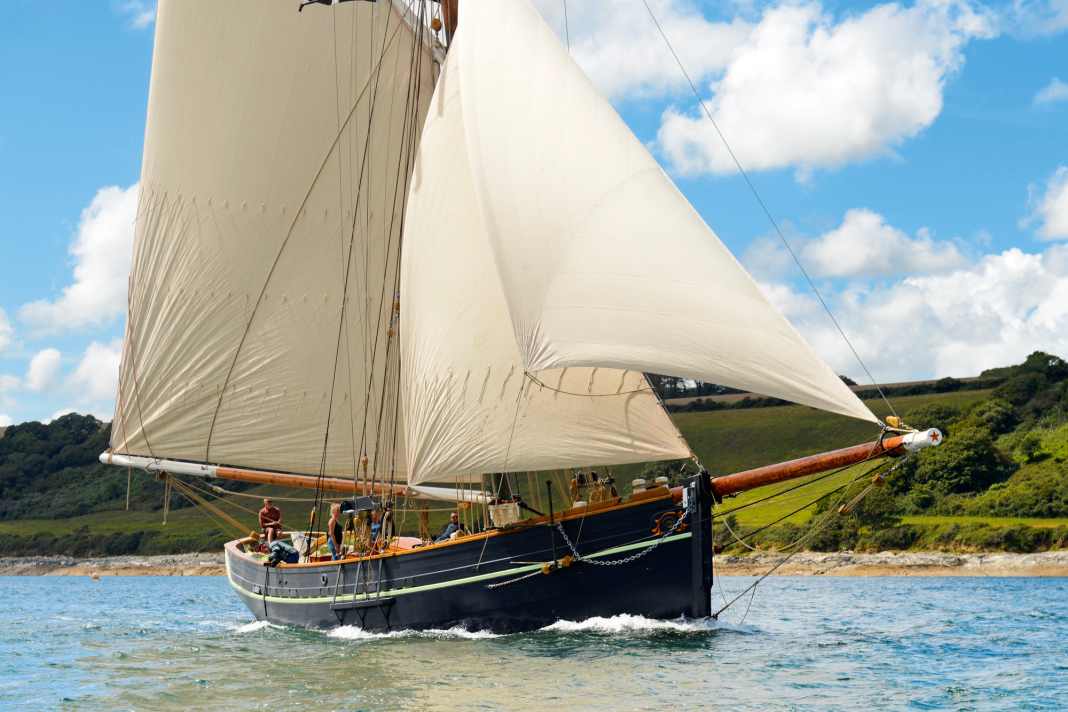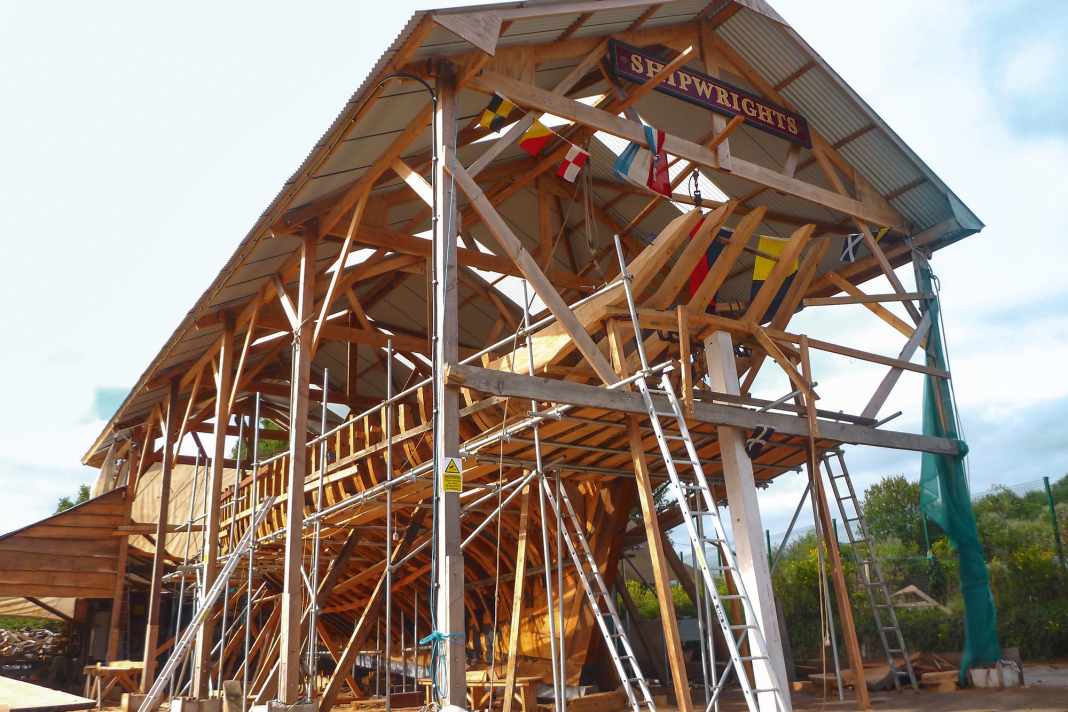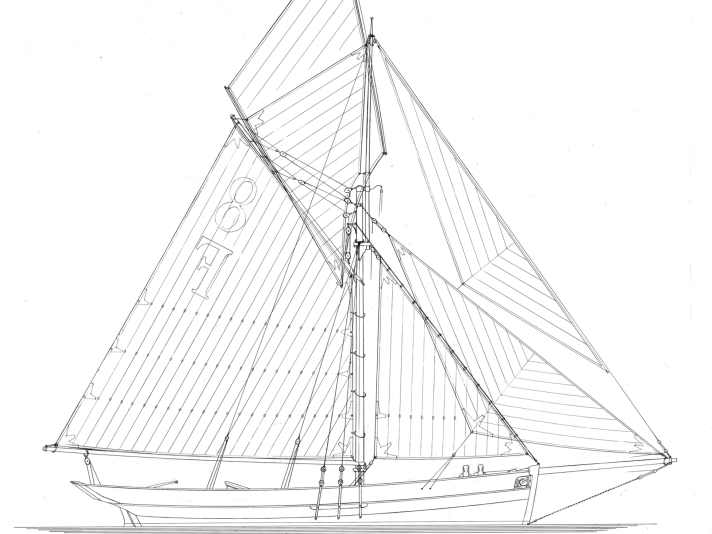





"We're on a collision course, Captain!" I shout frantically. "Stay on course. We'll pass in front of them!" comes the calm and clear reply. I'm at the helm of the brand new 68-foot pilot cutter "Pellew", trying to get used to the monstrous tiller as we thunder through the Carrick Roads off Falmouth and another gaff-rigged sailing boat appears off the port side. "Pellew's" builder and skipper Luke Powell immediately recognises the "Donna Capel", a converted 52-foot Belgian fishing boat. She belongs to his friend John Davison. "Let her come up close, we want to say hello," he calls to me.
Luke enjoys situations like this. In addition to his reputation as a builder of wooden pilot cutters - "Pellew" is his ninth and by far the largest - he is also known for his daring manoeuvres. I had often watched Luke's performances from afar, but now I was at the helm of his ship myself - and I was terrified. After all, such a huge boat can do all sorts of damage.
Other special boats:
With bowsprit, the replica of a historic pilot cutter measures 90 feet in length. It displaces 74 tonnes and has a sail area of 325 square metres. This makes "Pellew" the largest pilot cutter to have been built in the last 100 years. Its genesis was a long process with many obstacles, the sad culmination of which was the outbreak of the pandemic immediately after the launch. Nevertheless, the ship is a dream come true for Luke, which was created more than 20 years ago.
A long-cherished dream can become reality
It all began with a petite 38-foot pilot cutter called "Eve". Luke built it in Exeter in 1997, at a time when wooden boats were on the verge of extinction. The boat builder managed to find a buyer - and so he stuck with it. He gradually built seven more pilot cutters modelled on a boat type from the Isles of Scilly.
Under the company name Working Sail, Luke turned the village of Gweek at the head of the Helford River in Cornwall into a mecca for wooden boats. He played a key role in the resurgence of interest in sailing pilot cutters. But then the economic crisis hit in 2008 and orders dried up. Luke delivered the last new build in 2012. He then switched to nostalgic berth charter trips from Falmouth with his 46-foot pilot cutter "Agnes".
Business flourished with trips to the Isles of Scilly, Brittany and Ireland. Luke even found the time to write a very readable autobiography entitled "Working Sail", which continues to receive rave reviews. One day, he met Brian Pain through a boat building project. The pedagogue shares Luke's passion for traditional boats and agrees to finance a training project through his company Artysea.
It is the ideal opportunity for Luke to realise his long-cherished dream: "In my earlier research into the pilot cutters of the Isles of Scilly, I had noticed the ships from Falmouth that once competed with those from the Scillys. The 'Vincent' was one of the oldest and best documented boats of this type. She was built in 1852 and was in service from St Mawes until 1922. She ended her life as a houseboat on the Percuil River near St Mawes. There are many photos of 'Vincent' from the 1920s and I found the original model at the local boat builder Ralph Bird. I measured it and had the DNA I wanted to work with."
The patron saint once went into battle against Napoleon
Luke named his 68-foot design "Pellew" after the local hero Admiral Edward Pellew, who celebrated remarkable successes in the fight against the French during the Napoleonic Wars. Luke loves France and regularly attends the maritime festivals in Douarnenez and Brest. But he is also an ardent local Cornish patriot and wants his project to help keep the history of local boatbuilding and maritime culture alive.
His team includes two experienced and four young boatbuilders who still lack practical experience. The keel will be laid in February 2017 in a disused dock near Truro. Oak frames measuring 100 by 200 millimetres are placed on the 230 by 355 millimetre oak keel and planked with 55 to 75 millimetre thick oak, with bronze bracing. All in all, Luke estimates that around 100 tonnes of wood are needed to build the boat.
He uses bilinga for the deck and its structure, while the spars are planed from 15 tonnes of Douglas fir. This means that the "Pellew" is built to a much higher standard than the original. For good reason, as Luke reveals: "Most replicas are sailed much less than their originals. The biggest danger is therefore that they will be ruined by rainwater. Idleness is a killer for wooden boats!" It is quite ironic that the less boats are sailed, the better they should be built.
"Pellew" is built as authentically as possible
Unfortunately, in order to comply with today's building regulations, serious deviations from the original were necessary, such as the watertight bulkheads, wires made of steel instead of hemp and metal knees instead of wooden ones. In addition, "Pellew" was given a continuous lead keel weighing nine tonnes. A further 14 tonnes of ballast are in the bilges.
"The rig, on the other hand, is as authentic as it gets. Most pilot cutters have enlarged rigging. But we didn't want to build a boat to win races with. We wanted it to be a boat for training and therefore as seaworthy as possible. We therefore decided to follow the historical model and find out why things were done this way in the past. Experimental archaeology - just like they did when rebuilding the old Viking boats." Modern technology is also used to make "Pellew" easy to handle. "The anchor, for example, weighs 100 kilograms, so you need buoys to pull it up. The chain is very heavy, so we needed a mechanical anchor winch. And we also have electric halyard winches. In general, we have given a lot of thought to how we can safely operate such a large ship with a small crew."
Concessions are also made to the purpose of the boat as a training vessel. The cabin roof is extended over the companionway, there is comfortable seating in the saloon and a well-equipped galley with electric cooker, dishwasher, freezer and boiler. Not forgetting the showers in the comparatively comfortable sanitary area.
Launching with obstacles
Another challenge is the weather. In the winter of 2019/20, it was miserable even by English standards. "It was very demoralising," recalls his wife Joanna. "After Christmas, we thought spring was just around the corner - and then it rained non-stop for another four months."
The weather gods even thwart the launch of the "Pellew", which has to be cancelled at short notice due to strong winds. The crane arrives anyway and places the boat in the Truro River during a short weather window. There is no party, but thousands of people follow the event on social media. Three weeks later, the lockdown begins in the UK and work comes to an almost complete standstill. Fortunately, most of the rigging can still be completed. And when the restrictions are eased, Luke and a small team set about rigging the pilot cutter.
Finally, on 24 May, the "Pellew" sails down the Truro River and sails on the Carrick Roads for the first time. There is virtually no wind that day, but releasing the lines is still highly symbolic. When the set sails are reflected in the sparkling water off Falmouth, a big step has been taken.
Project resembles a rollercoaster ride
The comment on Working Sail's Facebook page says it all: "Our big green bird has wings." Luke, who was diagnosed with cancer during the work but managed to recover, says in retrospect: "Building the boat was the easier part. The external circumstances, on the other hand, were difficult." Dealing with the people involved in the construction took up the most space. "I often had the feeling that I didn't just have to overcome the boat-building challenges, but also many things that I couldn't control. The weather, my illness, Covid 19 - it all made things difficult."
Luke compares the project to a rollercoaster ride. It is good that this is now behind him and his team. Today, they are simply incredibly proud of what they have achieved. "The biggest surprise about the boat is the rig. When we built it, I was worried about whether such a large mast would be manageable. But it feels safe. If we had fitted 'Pellew' with a bigger rig, she would have seriously scared us at some point. But I'm confident that we can give her to other people to sail."
Back on the Carrick Roads, "Donna Capel" does the only right thing, much to Luke's disappointment, and changes course to pass us safely downwind. When we finally stalk her, I realise how little movement is needed at the helm to change course. Although the "Pellew" is such a large, heavy long keeler, she is surprisingly agile. This impression is confirmed when we turn in Falmouth Bay and I realise how easy it is.
The ship exudes the flair of a bygone age
In many ways, the cutter is a bit like a sheep in wolf's clothing: imposing to look at with its towering rigging, yet good-natured to sail - as befits a workboat of its pedigree. "Pellew" behaves in exactly the same way as "Agnes", comments Luke. A remarkable statement, considering the difference in size between these two boats.
Although she is closely modelled on the historic "Vincent", the "Pellew" has ultimately also become a Luke Powell design and will share many of her sister's characteristics. This also explains why Luke sails the 74-tonne vessel after just a few trips as if it were little more than an oversized dinghy.
Finally, we pass "Donna Capel" at a distance of just 20 metres and are rewarded with three cheers. Not for my skills as a helmsman, but for "Pellew" herself and for the fact that she is here and sailing in her home waters - in the shadow of the coronavirus and despite all the obstacles that have been put in her way.
This massive gaff cutter from another era is not only of great importance to Cornish sailors. Rather, it symbolises in the community of traditional skippers that even during a pandemic, great things can be achieved with perseverance and team spirit.
Construction of the "Pellew"




The "Pellew" has a historical model and was built as an educational project
The construction of the "Pellew" lasted from February 2017 to March 2020. Luke Powell had the idea for it twenty years earlier. The "Pellew" was a replica of the "Falmouth Pilot Cutter No 8 Vincent". It was delivered to the Vincent family from St Mawes in 1852. Until 1922, the original sailed in the channel off the coast of Cornwall as a pilot cutter and guided incoming ships to Falmouth. The replica was built to the highest standards and to fulfil the regulations for commercial sailing ships. In future, the "Pellew" will be used as a training vessel for young people and adults.
Technical data of the "Pellew"

- Designer: Luke Powell
- Shipyard: Working Sail Ltd.
- Torso length: 20 m
- Total length: 27 m
- LWL: 18 m
- Width: 5,5 m
- Depth: 3,1 m
- Displacement: 74 t
- Ballast: 23 t
- sail area: 325 m²
- Motor: John Deere
- PS: 125
The article first appeared in YACHT 18/2021 and has been updated for the online version.

